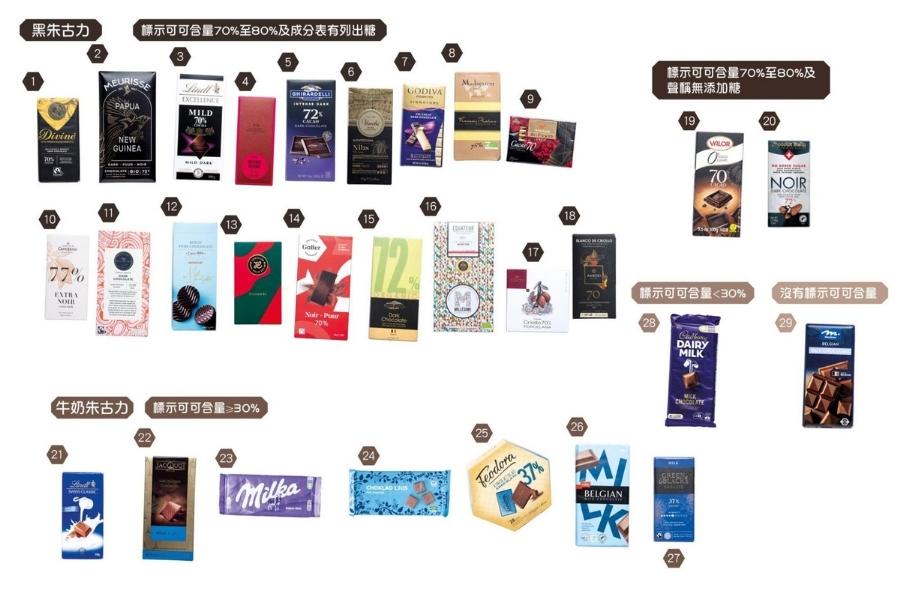The Consumer Council has released a report that highlights the nutritional composition and variations in quality among chocolate products. While chocolate is often hailed for its antioxidant properties, consumers should be aware of the significant fat and possible sugar content present in these treats.
The Council sourced 20 dark chocolate and 9 milk chocolate samples from various retailers: 20 Dark chocolate packets ranged in price from $28.8 to $160, and 9 milk chocolate packets ranged from $10 to $158. The report finds that all samples, except for 2 labelled as sugar-free, could be classified as “high-sugar foods”. On average, the sugar content in milk chocolate samples was a striking 90.8% higher than in dark chocolate samples. Conversely, dark chocolate samples contained an average of 28.5% more fat than their milk chocolate counterparts.
The study also revealed discrepancies between declared and actual fat and sugar contents in some samples, indicating the need for improved accuracy in nutrition labelling. Alarmingly, one sample exceeded the EU’s maximum permitted levels for the heavy metal cadmium, which, when consumed regularly, may pose risks to kidney function. Interestingly, the report found that price and quality did not always align, with lower-priced dark chocolate samples receiving higher ratings than some premium options.
To promote moderation, the Consumer Council advises adults to limit their weekly chocolate intake to 100g. This report serves as a reminder for consumers to be mindful of their consumption habits.
1 Sample Detected with Heavy Metal Cadmium, Exceeding EU Limit
Since there is no legal limit for cadmium content in chocolate in Hong Kong, the European Commission Regulation (EU) 2023/915 was used as benchmark, which sets maximum levels for cadmium in cocoa products.
Analysis of 20 dark chocolate samples revealed a 23-fold difference in detected cadmium levels, ranging from 0.039mg/kg to 0.937mg/kg. The highest level exceeded 17.1% of the maximum permitted limit for chocolate with a cocoa content of ≥50%. All milk chocolate samples stayed within the EU regulation’s limit, ranging from 0.009mg/kg to 0.092mg/kg, with one sample labelled <30% cocoa content and another unlabelled. Cadmium intake can harm kidney function, and the sample exceeding the limit was referred to the Centre for Food Safety (CFS). Lead was found in all dark chocolate samples, while 9 milk chocolate samples contained arsenic. However, none of the samples exceeded the maximum permitted levels under the Chinese national standard GB2762-2022 for contaminants in foods.

High Sugar Content in Milk Chocolate: Room for Nutrition Label Improvement
Based on each 100g sample, 20 dark chocolate samples were analysed and found variations in sugar content, with three samples exceeding the declared value on nutrition labels by over 20%. Among 9 milk chocolate samples, the measured sugar content did not exceed the labelled value by 20%. Milk chocolate generally had higher sugar content than dark chocolate, with an average of 53.8g per 100g, 90.8% higher than dark chocolate. In terms of fat content, dark chocolate had an average of 42.8g per 100g, while milk chocolate had 33.3g per 100g. Trans fat was found in two milk chocolate samples. Consumers are advised to consider nutritional values when choosing chocolates.
Possibly Carcinogenic Contaminant (PAHs) Detected but Within Limits
Polycyclic aromatic hydrocarbons (PAHs) are formed during high-temperature food processing. Among them, benzo[a]pyrene (B[a]P) is a known genotoxic carcinogen, while other PAHs are classified as “possibly carcinogenic to humans”. Testing of 15 dark chocolate samples and 8 milk chocolate samples detected PAHs in some samples, including B[a]P. However, the levels of B[a]P (ranging from 0.3 μg/kg to 0.6 μg/kg) did not exceed the maximum limits set by the EU, which is 5.0 μg/kg fat for B[a]P in cocoa products and 30 μg/kg fat for the total of four PAHs.
Dark Chocolate: Codex-Compliant Cocoa Content, Label Discrepancies
According to the Codex Alimentarius Commission’s CXS87 standard, dark chocolate shall contain, on a dry matter basis, not less than 35% total cocoa solids, of which not less than 18% shall be cocoa butter and not less than 14% fat-free cocoa solids.
The cocoa content of dark chocolate samples ranged from 70% to 80%. While all 20 samples complied with the Codex standard for total cocoa solids content, there were significant discrepancies with the labelled cocoa content.
Among the 9 tested milk chocolate samples, all complied with the Codex standard for cocoa solids content, with no discrepancies more than 10% from the labelled values, except one that was not labelled with the cocoa content. When consuming chocolate, moderation is advised due to its potential health benefits and sugar content.
Dark chocolate with higher cocoa content can provide more polyphenols. Caffeine in cocoa should be consumed in moderation, especially by children, pregnant women, and breastfeeding mothers. The European Food Safety Authority recommends a caffeine intake limit of not more than 3mg per kg body weight per day for children.
For more details on the report, please refer to CHOICE magazine issue 564.
Header image credit: The Consumer Council




